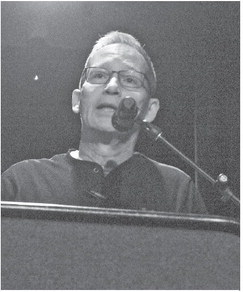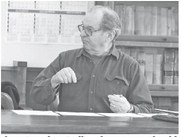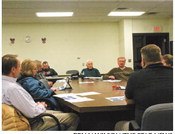Community looks at Medford school needs


If the Medford Area School District is serious about wanting to get a building referendum passed, the Nov. 29 informational meeting was a good start.
The meeting drew about 75 area residents to the Red White Theatre at the high school to learn about some specific needs in each of the school buildings. Community members also had the opportunity to offer input, ask questions and raise concerns.
Unlike recent referendum attempts, which were largely school-administration driven, district administrator Pat Sullivan started the meeting saying anything that would come forward would need to be communitydriven with the school staff serving as resources for information.
In light of that he turned the meeting over to local resident Dave Koester who had agreed to head up any effort. Koester spoke of the need to find common ground on ways to maintain and improve Medford school facilities.
“I think it is a disservice if we don’t make upgrades,” Koester said, noting that everything is either growing or it is dying.
Koester explained that there were the following three broad categories of projects: Maintenance and upkeep; improvements and additions; and “wish list” things that would be nice to have.
Principals from each of the buildings spoke about their specific needs going forward along with some general district-wide needs.
Elementary Principal Dan Miller spoke about the needs for additional classroom space for the 5-day PreK program which was expanded this year. In the past, the program was two days a week and split into two groups. The district was able to make it work with classrooms this year due to smaller numbers of sections in other grades, but Miller cautioned that the sections could return to what they historically have been which will result in a space crunch. He said they are looking at needing two additional classrooms.
Miller also highlighted plans to convert some of the existing library spaces in the buildings to use for instructional and special education spaces. He also noted the inadequate bathroom space in Stetsonville for the number of students in the school.
At the Middle School, principal Judd Hraby, said big-ticket building needs include the need to replace the doors in the front entrance and by the cafeteria which are showing a lot of issues and decay. He also noted the stage is original to when it was part of the old high school building and needs to be replaced.
At the high school, principal Jill Lybert said the most pressing need is in the tech ed areas. She noted the school is working to be responsive to the needs of area businesses to have workers ready and have worked to improve and expand tech ed programs in recent years.
She said ideally they would need two additional classrooms and two lab spaces for industry-needed coursework including in the metals shop and upgrades to the wood shop.
She said they also continue to need overhaul of the science classrooms to create more space, noting that with 29 to 30 kids per class there isn’t enough space for instruction and labs.
She also said the high school needs an additional small gym. She said the current gym is closed to physical education classes 22 days a year when other programs are using the space for everything from the reality fair to concerts.
In addition, Lybert said the district needs additional girls locker room space. “It is time to let our girls have equal facilities as the men do,” Lybert said.
Facilities manager Adam Schwarz highlighted the needs across the building in the district. He said the boilers in all the schools are 20 to 25 years old, that the foundation on the north side of the high school is leaking water into the basement, they need to complete the project to convert the lighting to LEDs throughout the schools, address outdoor lighting needs for security and safety, plumbing issues in the lower level of the high school, locker room needs, parking lot improvements and upgrades to the fire alarm system to get into compliance with current codes.
Community members also raised a number of other items including having ground level access from the lower level. Currently in case of fire, they would have to carry people up the stairs.
A resident asked about cafeteria needs, noting it was on a previous referendum. Lybert said it is still on the wish list and that they are crunched for space putting 325 students in there during each lunch period.
“Do we need it? Yes,” she said. However she said they wanted to keep this effort down to addressing the highest needs in the district and getting those needs met first.
This drew comments from residents saying they appreciated the short list, but said the district can’t go to referendum every couple years for things. They asked for the full list.
Athletic director Ryan Pilgrim raised concern about the bleachers at Raider Hall and that to bring them up to code will be a large expense. He also said there needs to be additional green spaces around the school grounds for practice areas, whether or not they are developed into formal field spaces.
Resident Fred Ebert asked about enrollment numbers and if the new housing in the area has resulted in any increases in enrollment. Miller said they were staying steady at seven sections per grade level across the district. However, he noted that they may be at the “low part in the enrollment roller coaster right now.”
A resident questioned the special needs numbers and how this compared to the past, noting it seems more pronounced now than when he went to school 50 years ago.
Special education director Joe Greget said there are 375 students in the district with IEPs. In addition there are many others with other specific needs. He said there are a number of students in wheelchairs, others with emotional and behavior issues.
“We have tried to be very responsible to the community,” Greget said.
Miller explained that back in the 1970s, special education students did not need to be in the schools, and that then they had to be in the schools but didn’t need to be educated, and then in the 1990s schools were told they have to actually try to educate special education students. Things changed again in the early 2000s when the state told schools that special education students need to make gains.
Miller said that 50 years ago those needs were there, but the expectations of what the schools needed to do for them has changed over time.
Ebert raised concerns about the impact of inflation on building materials. “Is this a good time with record inflation?” Ebert said, citing the county’s highway shop in Rib Lake and how that ballooned in cost.
He also raised concern about the ability of people to pay more in taxes to cover projects.
“A lot of us can afford it, but a lot of us can’t,” he said. Resident Bryan Schultz also expressed concern about impact of increased taxes through the community, noting that it impacts not just homeowners but business owners and others.
“I would caution going down this road again,” Ebert said.
Resident Brian Bormann said that if the district goes forward with a referendum they should separate the “luxury items” from the needs, saying that in the past, combining them would hold people hostage to voting for things they may not want. He called on the district to have two separate questions with the needs and the wish list items.
Koester wrapped up the meeting saying he felt some good progress had been made and looked forward to continuing the conversation as they moved through the process.


